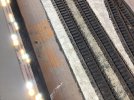To continue the saga.
The odd area with a disturbed edge, as described in my last, was lightly brushed with a paint brush to remove the excess and the whole section tamped flat with an offcut of aluminium angle iron, left over from the fiddle yard (the offcut can be seen in the next photo, atop the atomiser).
The area was soaked with water from an atomiser bottle, with a dash of fairy liquid added for good measure (to address the surface tension), and then a mix of 50:50 Pva/water (again with a dash of fairy or any other type of detergent added, although Meths can be used for the purpose I believe, still with washing up liquid) was applied via the former eye dropper you can see in the following photo:

A pipette for the purpose would have been better as it can hold a larger volume of liquid, but as this is only a tiny layout, I didn’t think it necessary.
‘Lewis Capaldi’ action ensures the glue does its job, and so is relatively easy to apply for those - like me - who’ve never attempted this before:

Some twelve hours or so later, the glue is only beginning to go off due to conditions in my unheated den, but notice the difference in tones between the areas treated in the first attempt to those in my second:



And to that all important height aspect, to ensure my humble sleepering isn’t lost into the bargain:


Overall, even though it’s early days, I’m quite happy with the look which I’ve convinced myself will pass for ash ballast on a decaying GWR branch line, set somewhere in Middle England or thereabouts. In fact, in comparison, my first attempt looks more like glued down sandpaper; the texture is okay, it’s just that it’s too uniform, if you get my drift?
I should add that following previous kind advice of fellow WT-er
@simond, who is far more experienced in these matters than I, I’d already purchased a tin of latex for the purpose, however I changed tack after seeing the rather robust technique employed by fellow WT-er
@PjKing1, whose methods I shall be following, which tends to make mincemeat of even the more traditional, rock-hard, Pva/water technique chosen, so there’d be nothing down for the more gentile approach with latex. Sorry, Simon

I’m going to leave it now for a good twenty four hours or so, after which I’ll redo the areas in my first attempt before carrying on.
If nobody minds my seemingly interminable ‘granny teaching’ methods at present, I’ll show you the results before proceeding with the ballasting.
Cheers.
jonte
 .
.
 ?
?
 .
.
 ?
?














 .
.











